Posted on October 08 2024

Cycle Tour Planning Guide
We have been bike touring since 2010. The planning and research of each trip we enjoy and it becomes part of the whole experience of discovering a different place. It is a good exercise, one that we warm to when the trip is a good one…. a bit like getting into a good book, the plot has to thicken. Each trip is different, however for us there must be a reason, which dictates the planning and what we take and how we do it. Travelling to Europe from Australia requires long haul flights and time spent travelling is determined by one's own personal commitments - family, work, business, health, finance.
Planning starts with the ideals. For example: The Balkans tour emanated from a region or a trade route, somewhere that has a large degree of the unknown, and has a diversity of cultures that may have vaguely been heard of and has the intrigue of difference (in this case) to our safe Australian living. The starting point was not an issue as there are so many international airports, the weather was top of the list and tourist pressure close behind. We wanted to start in the warmth, but also be along the Adriatic coast before the burning hot season. After scanning info on temperature and busy times we decided to start and finish in Sofia, Bulgaria, arriving late April, leaving early July – a 10-week period. This meant riding south of Sofia, crossing into North Macedonia to Skopje, then southwest to Lake Ohrid by which time we hoped the temperature was into the high 20s. Mid-May to mid-June we aimed to be touring the Albanian, Montenegran and Croatian coast into Slovenia, hopefully mild weather (before the heat of July/August) and before the high season of tourists. The last part of the journey would bring us through the hills of Croatia, Serbia then back to Bulgaria, historically still mild weather and a low tourist pressure area.
As with our more recent cycling adventures, we took our own bikes then designed a circular route to enable storage of our bike bags at our start and finish destination. Alternatives to this are to cardboard box the bikes, discard packing at the destination then arrange for new packing at the point of departure.
For our example, The Balkans, we purchased a return flight to Sofia, Bulgaria, and arranged to leave our bike bags and excess luggage at the accommodation.
We were then able to plan daily (roughly) based on distances for cycling, the terrain profile, rests in places of interest and our own connections to places and reasons for visiting … in this case, just to see whether our aspirations were somewhere near achievable.
Many people ask us how we go about planning our bike tours so here is our basic guide to get you started. If we can do it, you can do it. Be inspired to plan a bike tour and see the world in a different way - it is so rewarding.
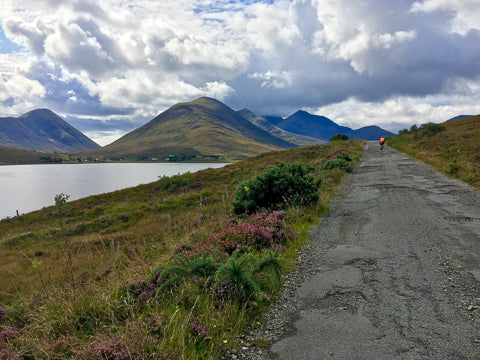 |
|
Dreams become plans that become adventures. The roads are not always smooth. |
Your 13 Step Basic Guide to Planning a Bike Tour
The questions that need to be considered.
Step 1: Why this Journey?
Have a reason for this journey. It gives focus and purpose to the planning and to the tour. Make it your story. Is it about scenery, nature, discovering other cultures, tracing history, family connections, exploring historic trading routes, cycling iconic rides (eg. Tour de France routes), following passions for architecture, food, wine, art, history, following movie or book locations? A special event to attend, visiting friends along the way, meeting new people, sharing a unique experience with loved ones, creating wonderful memories, or a mental or physical challenge?
Step 2: Where To Ride To?
Choose a destination based on your answer to the Why question. Home country or overseas. Narrow it down to regions, towns, destinations based on your reason from above. Make a list of desired destinations that can be linked together to create a route and follows your 'Why' theme. It should be people, places and things you are passionate about and are excited about visiting.
We usually start with a general idea from the Why question, then get the large Atlas/RoadMaps out and pour over them for days to see what is in the general area. Then we start on the internet looking at specific attractions within areas and towns and finding out what else is nearby that would be interesting.
 |
| Choose the lesser road and leave the traffic on the busy roads. Here we cycled on a gated stock road and left the traffic queue on top road. Much more fun. |
Step 3: How Long Will the Ride Be?
Obviously very different planning is required for 1 year versus a day trip. Can you go for a single day, days, weeks, months or years? Are you circumnavigating the world or doing a wine tour in the Barossa for 2 days? Depends on your family, work, business commitments, your health and your finances. Consider your physical fitness and start with shorter rides to test everything out.
Step 4: How Much Will It Cost?
What is your budget? Start with a total amount available, then try to fit as much as possible into that to achieve your reason for going. In Europe you may need to travel sections by train rather than fly or car hire. Often the alternatives chosen because of budget end up more fun. Begin with the essentials that are non-negotiable – your bike and cycling gear needed for the tour, airfares, trains, hire car fees, accommodation (apartments/hotels/hostels - look up a range of places on booking.com or Expedia to give you an idea; wild camping; park camping).. Then what is left can be calculated to create your daily budget for meals, extra fees for ferries or train connections, extra excursions or events – entry fees, event tickets, special adventure costs along the way and shopping. Don’t forget your travel insurance.
Step 5: When Should You Go?
Factors to consider:
- the weather at your destination. What are you prepared to endure? Heat, cold, rain. Have a Plan B in case of extreme weather.
- Tourism pressure. Time of travel can impact your budget if choosing peak times. Consider the busyness of roads and accommodation (check for local school holidays, public holidays and festivals). If you can jag a local festival on your tour it will add a highlight.
Your level of fitness - any training time required prior to the tour. Ride as often as possible prior to leaving. Go as soon as you can - don't leave it too long.
Step 6: Who Should You Tour With?
Will you travel on your own, as a couple, a group, or with a guided or self-guided tour, or a combination? If you pay for the guided tour or self-guided options, where the itinerary is set, much of the planning will be done for you. As a cycling couple we happily cycle our own self supported tours but have also done self-guided tours with other friends. Don't wait too long for other people to make a decision to join you. Choose your travelling companions carefully. Be prepared to go your own ways if it doesn't work out.
Step 7: What Bike to Ride?
The bicycle - touring bike, road bike, gravel bike, mountain bike, e-bike. Do you need to purchase a bike for your planned tour? Are you using your own bike or hiring a bike when you arrive? This will impact on the route you can plan. On road or off road? Do you need panniers or frame bags to carry your gear? If hiring a bike take some basic tools so you can make adjustments to the bike if needed. A badly fitted bike can be painful. It is worth having a good reliable bike that is comfortable for your style of cycling.
This important decision of what bike to ride will be determined by your answers to the other 12 points mentioned here. Where you plan to ride, how long you will be spending on the road (days and hours in the day), what road surfaces you will be riding on and how much gear you choose to carry.
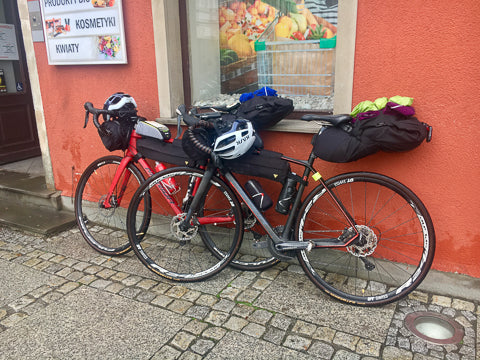 |
| For the Adriatic to Baltic tour we relied on our Merida Road Bikes with 32mm tyres. |
Step 8: How to get to the START?
How are you travelling to the starting point of your cycling tour or between cycling sections? Do you need to transport your bike by air, car, train, bus, boat? Do you hire a car, take your own bikes and base yourself at several destinations to ride out from? If arriving by air with your bike, where do you keep your bike bag whilst riding or will you use a disposable box to be left at the airport? We choose airlines with a 30kg luggage allowance which allows us to pack bikes and most of our gear into the one piece of luggage each. We then take a carry-on backpack with any extras. This is quite manageable in and around airports and train stations.
Do you need airport shuttles to your first point of accommodation? It is a good idea to book a larger vehicle ahead of your arrival, as a normal taxi can’t fit 2 large bike bags plus 2 people. We have on occasion had to show a driver how to fold his rear seats up as he had never had to do it before. He left with a smile on his face and we got to our accommodation. If driving/cycling with a hire car make sure it is a hatch back, station wagon or van and big enough to hold bikes plus bags.
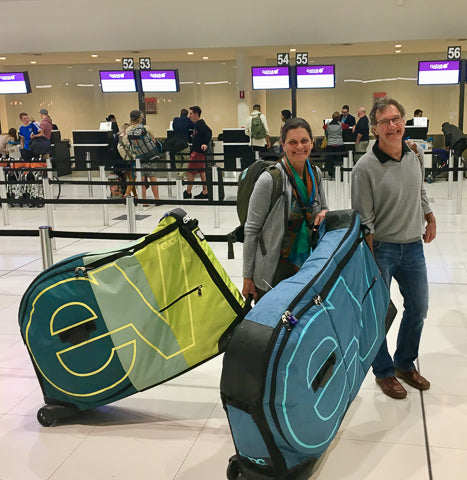 |
| Airline check in. Bike bags count as 1 piece of luggage. Check your allowances. |
 |
| Crossing Loch Lomond, Scotland, thanks to Cruise Loch Lomond. |
Between cycling routes, if travelling at any point by train – check ahead as not all trains have bicycle allocations. One occasion we had booked a train from Krakow to Prague plus 2 bikes. On the platform we were informed this train has no bicycle carriage. So the bikes had a booking with a whole compartment to themselves, much to the annoyance of all subsequent passengers looking for a seat! We had the compartment next door. Another train we travelled on had a separate wide doored goods carriage with plenty of room for bikes. We happily sat on the floor, played cards and shared a drink and a laugh with the locals rather than sitting in our allocated seats further down the train.
 |
 |
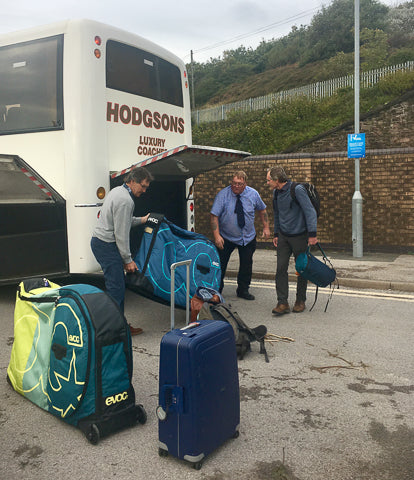 |
| Trains and Buses all part of the fun. |
Step 9: How to Plan the Cycling Route?
The logistical planning is based on bike type - mountain biking, gravel riding or road cycling (in general). There are several apps to assist in pre-planning routes. We’ve used Bikemap, Cyclers, Komoot and Ride with GPS along with maps.me for worldwide offline mapping (make sure you download the required maps before you leave). Suggest you stay away from google maps for this process.
If you have an open book of time then you might only plan a day or 2 ahead, but even in this case you may wish to know what you may achieve. Choose an app and put in the style of riding, then places of interest. Choose the distance you believe you will travel each day and fit these around points of overnight stays and attractions. We then look at the daily profile and adjust to flat days being longer and hilly days shorter.
Look for the type of roads you like, whether that be cycle paths, mountain bike tracks, minor roads, state roads. We suggest you find ways to avoid major highways to connect your chosen way points and destinations. Allow time in each day to stop and look along the way.
Other factors to consider:
- Routes offered by organised bike tours and popular routes on Strava.
- Check there are opportunities to purchase a meal or food supplies at overnight stops.
- If cycling in remote regions or wild camping – how many days supplies will you need to carry?
- Choose places you want to see, not because someone else said you have to go there.
- Make use of the local Tourism Information outlets when you arrive to get local maps and information.
- Talk to cyclists you meet along the way and listen to their tips and suggestions. Some work, others don't.
 |
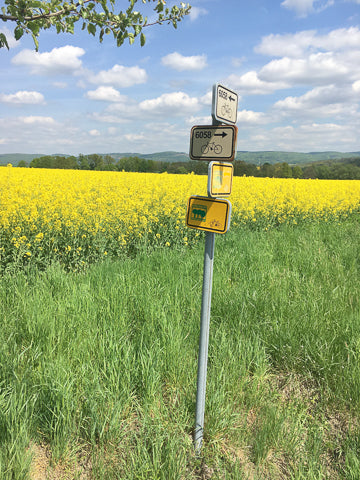 |
| Just follow the signs and check your own route. |
Step 10: Where to Stay when Cycling?
Do you plan to just wing it and see how far you get each day and then find a place to stay, or book ahead and have a destination each day? This will depend on your budget and timing. Do you want to camp in campgrounds or go wild camping? Stay with bike friendly hosts like Warm Showers, or visit family and friends along the way? Hostel, Hotel, or apartment, basic to luxury?... or a mixture to add a treat occasionally. Check your accommodation is bike friendly and has somewhere secure to store your bike. Try to get accommodation on the ground or first floor for ease of access. Many accommodations have narrow, steep or even spiral staircases, possibly no lifts or lifts that are so small you can't fit your bike in the lift. Checking the location of your accommodation in relation to your route, a restaurant for that night or ongoing transport, eg: trains, airports, ferries etc., can make it easier on arrival and departure. The guided and self-guided tour options have much of this pre-arranged.
We usually opt to pre book accommodation, as at the end of an exhilarating day of adventure, it is nice to quickly get settled at the place, get your bearings and replenish with fuel (food). We have found it useful to stay centrally to our planned destination to enable us to walk in the evenings, enjoy our surrounds and reflect on the day’s activities. We do most of our bookings through bookings.com as many we can cancel prior to arrival if we need to and you don't need to pay up front. Pre booking can be for the entire tour or just one or two days ahead of the planned route, dependent on the tourism pressure and the amount of accommodation available.
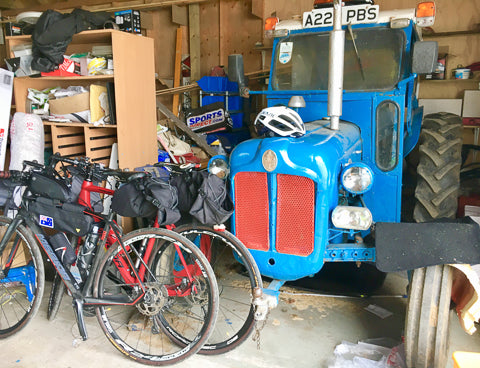 |
| Bike friendly accommodation - a cosy shed or sharing your bedroom! |
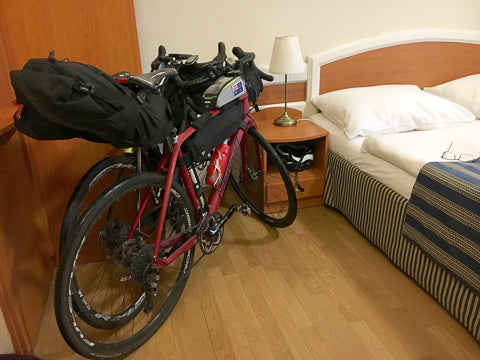 |
Step 11: What to Pack for a Cycling Tour?
Your pack list depends on the type of touring you have chosen - how much you can take and how you are going to carry it; how long you will be on the road and where you plan to stay. Less is always best, weight is critical. Take time, make a list, lay it out, discard half of it and try again. Organised tours transport your luggage for you, so being ultra-light is not that critical. Other options are panniers (the long-term world travellers have multiple panniers), or frame bags (popular for shorter bike packing and bike touring holidays as they are more streamlined than panniers, work on road and gravel bikes and minimise how much you can carry).
Sections in our pack list include:
- Bike, bike bags - seat post bag, frame bag, front roll bag, top frame bag;
- Bike accessories - lights, Garmin, bell, mirror, bike-lock, pump, helmet, drink bottles, riding glasses, riding gloves, riding shoes;
- Bike tools & spares;
- Cycling clothes - Full kit - 2 changes of ConnalKit;
- Wet weather gear (gilet, rain jacket, shoe covers) and layering garments (wool base layers, neck warmer, sleeves);
- Off bike clothes - ConnalKit can be on and off the bike, lightweight pair of shoes;
- Toiletries - keep to an absolute minimum – use mini travel bottles for the essentials, top up when needed. Don't forget sunscreen and insect repellant;
- Medications - butt cream, anti-inflammatories, pain killers and prescriptions;
- Phone, camera, batteries, cables, chargers & adaptors (these are all heavy so keep to a minimum);
- Personal travel items - passport, tickets etc;
- Small travel towel and clothesline;
- Emergency kit - first aid, thermal blanket, poncho, pocket knife, matches, compass (personal locator beacon & solar chargers if cycling remote);
- Food & water - quantity depends on distances travelled, weather and availability of supplies;
- Dry bags (to separate items and keep them dry);
- Mini backpack for walking adventures or shopping, zip lock bags (good for breaking food down and not carrying surplus packaging);
- Rags or wipes (for bike cleaning);
- Ziplock ties and a pair of shoelaces (never know what you have to hold together);
- Gaffer tape - handy for repairing shoes or other things;
- Tissues or toilet paper (not always supplied);
- Cup and cutlery set for picnics;
- Notebook and pen, pack of cards or set of Yahtzee dice;
- We always take our mascot ‘Little Wolf’ to ride along with us;
- Ladies – a colourful feather weight silk scarf can help you feel a bit jazzed up in the evenings and will keep your neck warm too.
If you choose to camp – another list is needed for required gear – just keep it as light as you can.
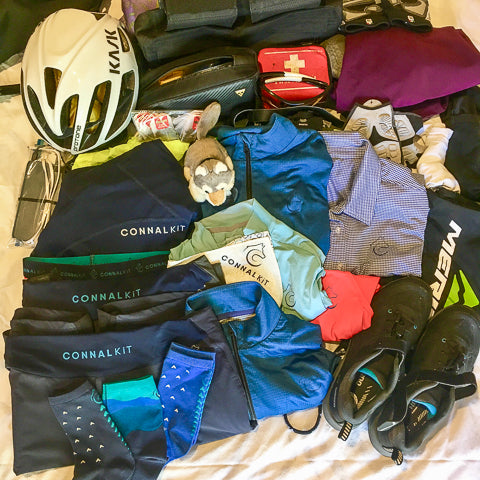 |
| What and how to pack for a bike tour. |
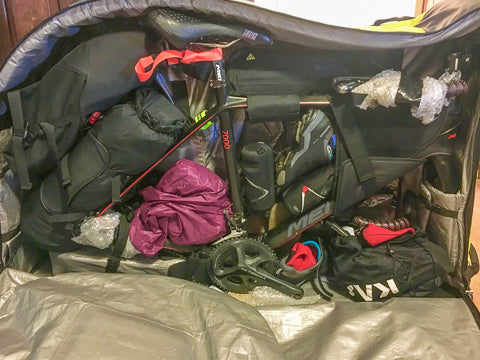 |
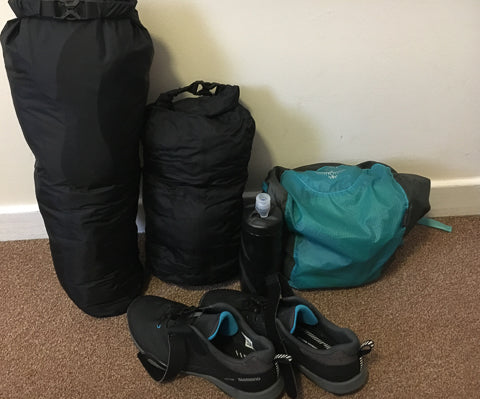 |
| The layout, packed bike bag and on the road bags. |
Step 12: How to keep Me and My Bike on the road?
Important to check your bike thoroughly before every day’s ride and clean your bike. A set of allen keys should be in your hand to check and tighten bolts.
Be patient and calm and trust your own judgement.
Be aware of emergency contacts in the countries you are travelling in.
Be prepared to perform first aid if needed and ask for help.
Wash at least your knicks and base layer every night.
Keep yourself nourished and hydrated.
Celebrate small achievements to keep motivated and lighthearted.
Keep everything charged up whenever you have the opportunity.
Download your planned route to have access to offline GPS.
Stop to read the signs and check you are on the right path.
Look for the local Information Centres – they often have better local information than what you can find on the internet. Talk to the locals. When cycling in a country where you do not speak the language – try to learn some basic phrases for polite responses or essential questions. Sign language, pointing, sketching and a happy attitude will usually get you through. Just don’t raise your voice – deafness is not the problem. Research the local customs to avoid offending the locals with your dress, behaviour or actions.
Celebrate moments, picnic in the most beautiful places, and shelter where you can. Be prepared for mental challenges of being lonely, bored, scared, cold, tired, exhausted and hungry. These are the times when you just need to push through to get the rewards over the hill. But most of all keep smiling and be in the moment whatever happens. Sometimes the hard days become the most wonderful memories.
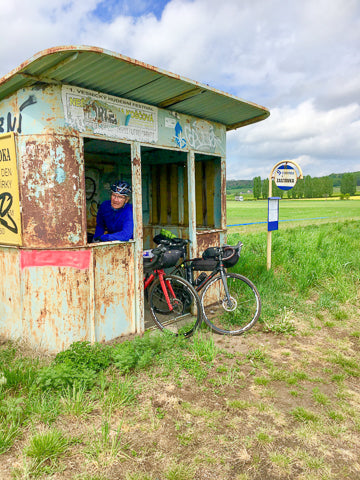 |
| Shelter where you can. |
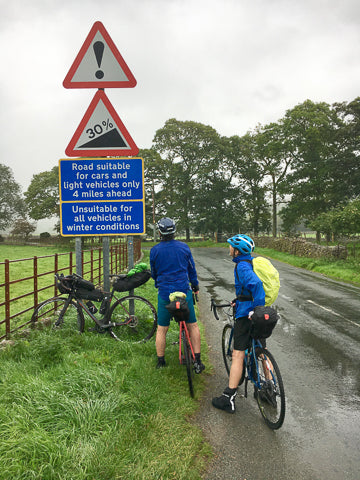 |
| Expect the unexpected and take up the challenge. |

|
| Be prepared to repair! |
Step 13: Plan well and Just Do It! Just Ride and Go Explore.
Spend time researching and planning your trip. The more preparation you do the more enjoyable the journey will be. A bike tour can be physically and mentally demanding. Be prepared for both. If in doubt google it - you can find tips on nearly everything you need. Then just do it. You will learn what type of touring you like and how to best plan it. That is part of the journey. Enjoy your journey, have fun and smile.
Many people have written books and blogs about their bike tours. We write blogs about ours - you will find them on this site and more are in the making. Our more recent tours are also on our YouTube channel. We have listed some links at the end of this blog to get you started. Don’t forget to (1) have some record of the adventures you have and (2) ride with Connal Kit clothing.
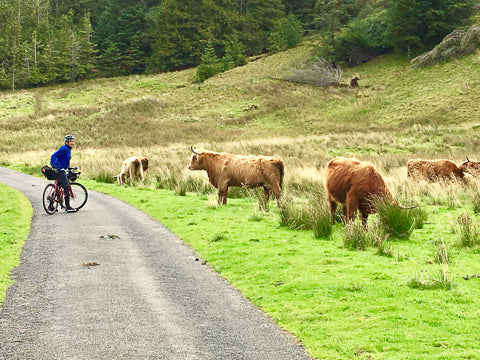 |
| Have fun meeting the locals! |
 |
 |
|
Local markets are always tempting. |
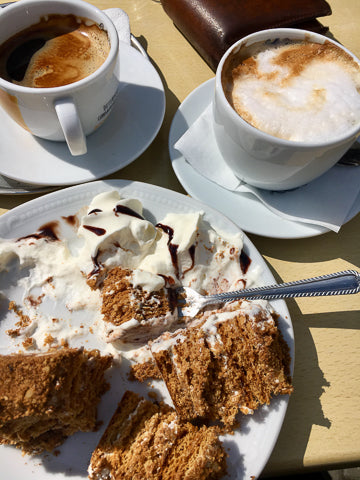 |
Our experiences have come from trying a number of bike touring options over the years – each trip required different planning, but every trip was special and memorable. Stories of our rides are being posted in our blogs - see the links below. Some of the journeys we have taken include:
Cycling Trips in Europe and the UK:
Balkans Cycling Adventure (BCA) 2024 - Starting and ending in Sofia, Bulgaria. Self planned and unsupported, as a couple. Took our own gravel bikes, carried all our own gear, booked accommodation on the fly. Bulgaria, North Macedonia, Albania, Montenegro, Croatia, Slovenia, Italy (just), Serbia, returning to Bulgaria. 8 countries, 10 weeks.
Adriatic to the Baltic Cycle Tour (ABC) 2023 - Starting and ending in Prague, Czech Republic, train to Verona (Italy) to our cycling starting point, then cycling to Chioggia to touch the Adriatic Sea, before turning and heading north. This took us through the Alps and all the way to the Baltic Sea. Cycling through Italy, Austria, Germany, Poland before turning and returning to Prague through Czech. Self planned and unsupported. 5 countries, 8 weeks
Prague to Krakow – self planned, travelled as a couple, took our own road bikes, flew in and out of Prague, used the train to return from Krakow to Prague, pre booked accommodation, carried all gear on bikes with frame bags, left our bike bags in Prague. Pre booked airport pickups to ensure bike bags could be fitted.
Scottish Highlands & Isle of Skye – self planned, travelled as a couple, took our own road bikes, flew in and out of Edinburgh, left surplus gear with friends in Glasgow whilst doing a circular route, pre booked accommodation, carried gear on bikes for several weeks. Hired a car and travelled by train and bus between other activities and the next cycle trip a bit further south.
England Coast to Coast (followed on from Scotland) – self planned, travelled as a couple with another friend (he hired a bike) – booked luggage transfer for surplus luggage to be delivered to end point, pre booked accommodation, carried gear on bikes for a week.
Spain & France – Pyrenees circuit – self planned, flew in and out of Barcelona, Spain, with our own road bikes, travelled as a couple, pre booked accommodation, combination of hire car to move between regions and cycling circuit routes from places we stayed. Good option to cover a bit more ground.
France - Brittany. Hired bikes which we almost had to rebuild. A week of cycling from our base in Quimper in the south west of Brittany.
Switzerland – Self Guided Cycling tour of a week with a group of 8 friends. Tour company provided hire bikes, accommodation, luggage transfers, maps & information. This route also took us into Liechtenstein and Austria.
Germany - Sonthofen - hired mountain bikes for one day cycle to Giebelhaus and Schwarzenberg in the mountains of the Overallgau region of Bavaria. With another couple who live in Sonthofen.
Vienna to Prague – Self Guided Cycling tour, 2 couples. Tour company provided hire bikes, accommodation, luggage transfers, maps & information.
Kitzbuhel, Austria – Self guided one day ride with hire bikes.
Beaune, Burgundy, France – Self guided week of circuit rides from one central location. Hired bikes, Accommodation pre booked in one location, hired bikes & obtained local information & maps from local bike store.
Františkovy Lázně & Cheb, Czech Republic – Self guided one day ride with hire bikes.
Cycling Trips Within Australia:
Connal Cycle Tour 1 Wheatbelt Western Australia
Connal Cycle Tour 2 Mid West Western Australia
Connal Cycle Tour 3 Goldfields WEstern Australia
Connal Cycle Tour 4 Wheatbelt Western Australia
Fly and drive with road bikes to Adelaide for self-guided riding with friends at several Santos Tour Down Under events. Cycling Adelaide City and the regions of the Adelaide Hills, McLaren Vale and the Barossa Valley.
Road trip across Australia from Western Australia to Tasmania with riding stops along the way. Returning via the Red Centre and Alice Springs. This road trip included road cycles in all the states we travelled through. Western Australia, South Australia, Victoria, Tasmania, New South Wales and Northern Territory.
And of course our regular weekly cycling within our home region of Dunsborough, Margaret River and Busselton with the odd excursion further afield into the delightful neighbouring countryside of Nannup, Donnelly River and the Ferguson Valley.
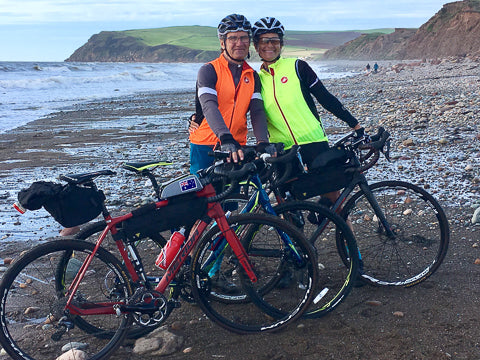 |
| Starting the coast to coast in England - making memories. |
More Resources and Travel Tips:
A few resources to get you started:
Clothing: right here of course with Connal Kit designed specifically for cycling adventures. Another recent discovery which has proved incredibly versatile (replacing the silk scarf) is a SunBella Sun Wrap.
Accommodation: Most of our accommodation bookings are made through bookings.com where we take the free cancellation option to maintain some flexibility. We also always communicate with the host to check secure bike storage options and accessibility. Some areas are good to use Airbnb but payment is usually needed up front and not so flexible for cancellations. The initial search with AirBnB does not pinpoint the location of properties which can be quite critical when cycling. This is only given once the booking is made.
Itinerary: A valuable itinerary tool we use is an app called Tripit (by Concur) which can be shared between travellers. It will keep all your flights and bookings in one place on your phone with full booking details. Saves carrying around paperwork.
Internet: Mobile phone connectivity when away from our home networks – we recently used Airalo esims for data and were very happy with them. Use our Referral Code: JEN8558 to get $5 off (Australia).
Money: Credit cards – need to have 2 options. Hire car companies need a credit card not a debit card (don’t get caught out). We have tried various for international travel. Currently we are using Wise Credit Cards. Preload in home currency and conversions are made on the date of purchase or you can preload in chosen currency. Rates are very good. Use our referral link.
As a backup we also carry our local Mastercard or Visa credit card.
Cash - withdraw an amount of cash in the local currency on entry to a country.. Accommodation, bar, restaurants and shops sometimes only work with cash.
Mapping and Navigation: Early in the planning we purchase more detailed regional maps. Great to see the bigger picture spread out on the table.
For Europe and UK these two sites are a good starting point.
Cycling UK: Cyclists’s Touring Club (CTC)
EuroVelo: The European Cycle Route Network
These cycling route planning and navigation tools are all subscription based. Some work better in certain countries and lack coverage in others. An amount of basic functionality is usable without joining up.
Komoot – subscription based bike route planning and navigation.
Bikemap - subscription based. User generated cycling route collection.
Ride with GPS – subscription based.
We hope this gets you started and is of help in planning your cycling adventure.
Let us know where you have been.
Regards Jen & Greg
ConnalKit (Updated October 2024)
 |
| The Silk Scarf Trick. Out to dinner wearing layered wool and the silk scarf. |

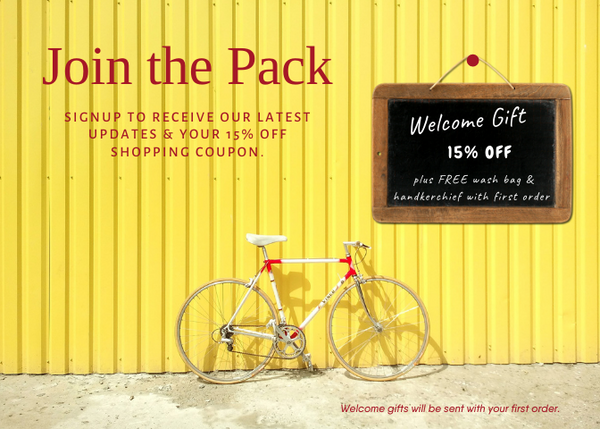
Hallo Jen and Greg,
I saw your names 🤓
Hallo and well done with your trips.
I’ve been living on my bike for the past 18 months. Having covered 11,000kms between lockdowns and doing voluntary work during the winter months.
Why do we need a reason to cycle? Over planning things, ties you to a schedule and takes away the freedom to be spontaneous.
For sure I know where I want to be, in a certain amount of time. For example in May last year I wanted to see friends in Berlin, and I knew that it would take me about five weeks from Huvela (Spain). The exciting part of the trip was not knowing where I would be each night. I often switch my phone off for days and use only my compass for navigation. Or if I see a road that has good energy, I will go many kilometres out of my to travel it.
Being free to ride is reason enough to travel by bike.
Namaste,
Paul
PS I didn’t see your names mentioned in this article.